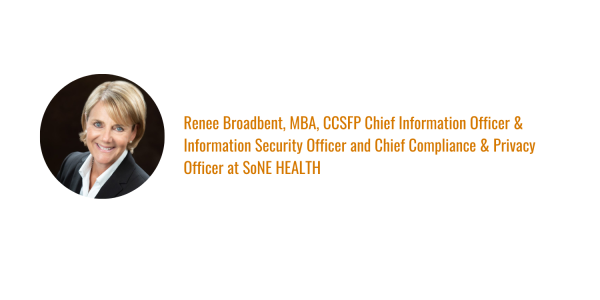By: Renee Broadbent, MBA, CCSFP, Chief Information Officer at SoNE HEALTH
The need for value-based care in today’s healthcare environment is clear: one in three Medicare beneficiaries has four or more chronic conditions and 6% of patients represent 75% of healthcare costs in the United States (1). The shift to value-based care is accelerating and creating more of an opportunity for payors and providers to join together with a common goal to improve care and health outcomes at a lower cost. To realize the full value of the payor-provider alignment and value-based care, both need to make use and sense of the vast amount of healthcare data. The volume of healthcare data doubles every 73 days (2). Obtaining and sorting through all that data to get the correct data for treatment and transforming how we deliver healthcare is challenging. Most organizations struggle with the technology and resources needed to manage it and make sense of it all. Both payors and providers agree that having a 360-degree view of a patient is critical for treatment and is key for value-based care success. This is where semantic interoperability comes into play.
What is Semantic Interoperability?
Semantic interoperability refers to the ability of different information systems and software applications to effectively communicate, understand, and exchange data with each other, while accurately interpreting and preserving the meaning and context of the data being shared. It ensures that various systems can understand the semantics or meaning of the data, rather than just transmitting, and receiving it as raw, unstructured information.
In other words, semantic interoperability defines how different systems can achieve a mutual understanding of the shared data, including the concepts, relationships, and context they represent. It involves establishing common data standards, terminologies, and ontologies to ensure accurate interpretation and meaningful exchange of data across diverse systems and organizations.
Semantic interoperability plays a crucial role in enabling and enhancing value-based care. By ensuring that different health IT systems can effectively communicate and understand each other’s data, semantic interoperability enables seamless data sharing and exchange. This, in turn, facilitates enhanced coordination of care, supports clinical decision-making, and enables the development of sophisticated analytics and population health management strategies.
Value-based care emphasizes delivering high-quality care while controlling costs, and semantic interoperability plays a key role in achieving these goals. It allows for the aggregation of disparate data sources, facilitating a comprehensive view of individual and population health. This, in turn, enables providers and healthcare organizations to identify trends, patterns, and insights that can inform evidence-based care delivery and identify opportunities for cost reduction and efficiency improvement.
Moreover, semantic interoperability empowers the use of advanced clinical decision support systems, helping providers make more informed decisions at the point of care. By integrating patient-specific information from a variety of sources, such as electronic health records, medical literature, and best practice guidelines, semantic interoperability enables the delivery of personalized and targeted interventions that align with value-based care principles.
Overall, semantic interoperability strengthens the foundation for value-based care by fostering comprehensive data sharing, enabling advanced analytics, supporting clinical decision-making, and facilitating population health management.
(1) & (2) – Wolters Kluwer – Information Sharing Across the Healthcare Ecosystem
